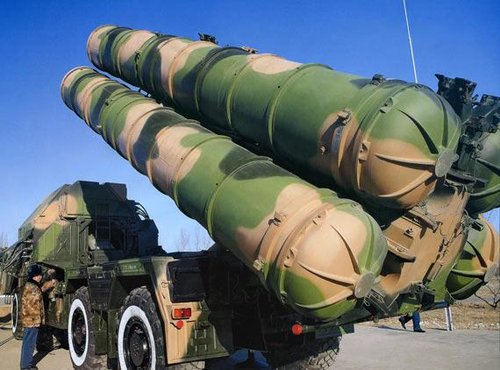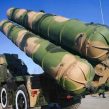
China’s Rising Profile in International Arms Sales
Publication: China Brief Volume: 9 Issue: 25
By:

The year 2009 will likely be remembered as the beginning of a more assertive phase in Chinese foreign policy, as seen in Beijing’s stance on reform of the international financial system, its massive investments in foreign countries, and in particular its investment in and acquisition of energy assets. At the same time, China’s newfound assertiveness is also manifested by the inroads it is making in the global arms markets. Beijing’s rising profile as an exporter of arms attests to the progress made by its defense industries because it shows that China is beginning to master the complex challenges involved in producing quality military systems for foreign customers. Moreover, these products duly give China greater competitive viability in those markets. For instance, China has begun to develop its own competitive weapons systems (e.g. its first large military transport plane) (Nikkei Telecom 21, November 13), and may soon start selling other post-Soviet states its own weapons (e.g. the L-15 Falcon advanced jet trainer to Ukraine) (Jane’s Defence Weekly, November 23).
China’s emergence as a major arms exporter owes much to its successful indigenization (aka piracy) of Russian weapons and technologies that Moscow has sold to Beijing since 1990. This indigenization is a long-standing and deeply ingrained practice going back many years, and a systematic Chinese policy to advance the technological level and quality of indigenously produced weapons while reducing its dependence upon foreign suppliers (See "Recent Trends in Russo-Chinese Military Relations," China Brief, January 22). As a result, China’s advances in the arms sales markets come largely at the expense of Russia, as Chinese arms are becoming more competitive in those markets where Russian weapons and technologies have established a niche in recent years. Naturally, this situation discomfits arms sellers in Russia but policymakers in Moscow still insist on maintaining a strong relationship with Beijing even if Russia will sell China fewer weapons than before (ITAR-TASS, September 30; FBIS SOV, September 30). Thus, it remains unclear—to what degree if any—China suffers any penalties from its indigenization policy. In this way, China is becoming a direct competitor to Russia in the international arms markets, and even among the commonwealth of independent states (CIS).
The scope of China’s arms sales offensive is global. In Africa, China sells arms to those states from which it buys oil and gas or where it has gained access to explore for oil or gas (e.g. Sudan). Yet it is also clear that China is competing with Russia in the African arms market with indigenized versions of Russian-made weapons systems. For instance, according to Japanese reports China is “frantically” trying to sell SU-27 fighters in the guise of China’s J-11 Fighters to African states (Foresight, February 19; FBIS SOV, September 30). Similarly in South America, an area that Russia has targeted as one of the key future markets where it hopes to increase its market share, China is beginning to offer the same states competitive weapons systems (Interfax-AVN Online, October 22; FBIS SOV, October 22). In 2010, China will deliver six of the eighteen K-8 Karakorum trainer or light attack planes that it sold to Venezuela, and is lending Ecuador $52 million to buy aircraft for its air force. In early 2009, Ecuador signed a contract for $60 million to buy Chinese air defense radars; its first purchases from China in 15 years (Defense News, November 28).
Perhaps the most significant example of China’s aggressive arms sales posture can be found in the Middle East, the key market where it competes with Moscow and Washington. Iran has already reached the point where it can appeal to China for defense exports (ironically probably knock-offs of Russian weapons). Thus, Iran has raised hints that if Russia does not sell the S-300 SAM for which it signed a contract in 2007, Tehran might turn to the HQ-9 surface-to-air missile (FD-2000) as the alternative (Press TV, May 10). As an Iranian report noted:
As Iran’s quest for the advanced Russian-made S-300 air defense system is believed to have hit rock bottom, a report by RIA Novosti said Tehran is eyeing a Chinese-made HQ-9 surface-to-air missile under the name FD-2000—recently put on the export market. The HongQi-9/FD-2000 reportedly combines elements “borrowed” from Russia’s S-300 and America’s MIM-104 Patriot. It uses elements of the Russian system’s “solid rocket, aerodynamic layout, gas-dynamic spoilers and launcher technologies, as well as some search and guidance systems.” The missile has a range of 7-125 kilometers for airborne targets—a range much lower than the 150-kilometer range of the Russian S-300 PMU1. The Chinese system’s range for missile targets, or air-to-ground missiles, is 7-50 kilometers, with a firing altitude of 1-18 kilometers. Its range for cruise missiles is 7-15 kilometers, at a firing altitude of 0.025 kilometers. The range for ballistic missiles is 7-25 kilometers at a firing altitude of 2-15 kilometers (Press TV, May 10).
Egypt, a former Russian client who, like others, became frustrated with the poor quality of Russian weapons, also began switching to Chinese arms (FBIS SOV, February 19). Moreover, China has announced that it will compete with Russia and the United States for entry into Turkey’s surface-to-air missiles (SAM) market (FBIS SOV, August 31).
Finally, in South and Southeast Asia where China has sold its weapons and technology—which are generally copies of Russian systems—and in particular to Pakistan, China is intensifying the regional arms race with India, and competing with Russia in Southeast Asia. Specifically, China’s recent sale of at least 36 J-10 fighter jets, and the possibility that it could sell Pakistan up to 150, is a testament to its strength in the Pakistani market and to the enduring quality of the regional arms race with India. This sale is perhaps the most impressive testimony to China’s new assertiveness in the global arms market (See "J-10: The New Cornerstone of Sino-Pakistani Defense Cooperation," China Brief, December 16).
Accordingly, China’s Aviation Industry Corporation (AVIC) has also emerged as a rival to Russia’s Sukhoi and MiG Aircraft that are marketed abroad by Rosoboroneksport, Russia’s arms seller, in Indonesia, Pakistan, the Philippines and Eastern Europe, and eventually in Africa with regard to helicopters. Meanwhile, Pakistan will soon roll out its first indigenously produced JF-17 that China copied from Russia and sold (FBIS SOV, October 7). Indeed, it has become clear that China has sold or otherwise transferred Russian defense technologies like RPGs, the PK-10 Assault gun, howitzer ammunition and anti-tank rockets to Pakistan, much to the anger of Russian officials (Kanwa Asian Defense, August 2009; FBIS SOV, August 31).
Beyond these considerations, the deal with Pakistan also has important geopolitical ramifications. Clearly, China is concerned about the growth of Indian military power and political standing and Beijing is showing that it intends to restrain New Delhi by keeping it preoccupied with Pakistan. This sale demonstrates the long-standing policy of China in action. Second, it also shows that China will not supinely let the U.S. challenge it for primacy as the main foreign influence in Pakistan. As the Times of India reported:
Beijing is keen to reduce U.S. influence on Pakistan, which will make it easier for it to deal with India, sources said. Washington’s recent decision to extend massive financial assistance to Islamabad is seen in some quarters as a policy setback for China. It is now trying to get back its influence over Pakistan by selling two squadrons of advanced jets, sources said. Even more significant is Beijing’s eagerness to share advanced technology with Pakistan, which is something US suppliers are usually reluctant to do. A report from Pakistan said it wants to buy a larger number of warplanes from China besides the two squadrons of J-10 fighter planes it is buying at the moment. A Pakistani official described the plane sales deal as a "landmark" in Pak-China relations (Times of India, November 11).
In spite of agreements in late 2008 where China agreed not to create any suspicion of copying or exporting weapons using Russian technology to third countries in return for a renewed effort at a cooperative relationship with Russia, China failed to adhere to the agreement and it led to a temporary blocking of Russian arms sales to China (Sankei Shimbun Online, February 2; Kanwa Asian Defense, August 2009; FBIS SOV, August 31).
Conclusion
These arms sales and their scope indicate that China fully intends to become a permanent competitor with Russia and eventually with European and American firms in the international arms market. There does not seem to be a way to stop Beijing from indigenizing systems that it has received from Russia other than to curtail sales to it. Yet even if Russia stops selling China arms, an action that entails serious costs for Russia, it may be too late to stop Chinese firms from introducing their own competitive refinements and improvements to a host of weapon systems. Moreover, Chinese systems are attractive to countries based on price or in return for the political and economic support that China gives to their regimes (e.g. Sudan). Iran’s example also suggests what could happen to Russia if China supplants it in the arms market, namely a turn from Moscow to Beijing in Iran’s foreign policies. And the rivalry for the Turkish SAM (a project whose urgency grows with Iran’s rising missile capability) suggests that Russia in some cases may actually not even be competitive to customers relative to China. In other words, in this manifestation of China’s assertiveness in the international arena this is only the beginning of China’s rise in its arms sales policies, just as this is only the beginning of its self-assertion in financial system reform and other areas of international affairs.
[ The views expressed here do not represent those of the U.S. Army, Defense Department or the U.S. Government.]





